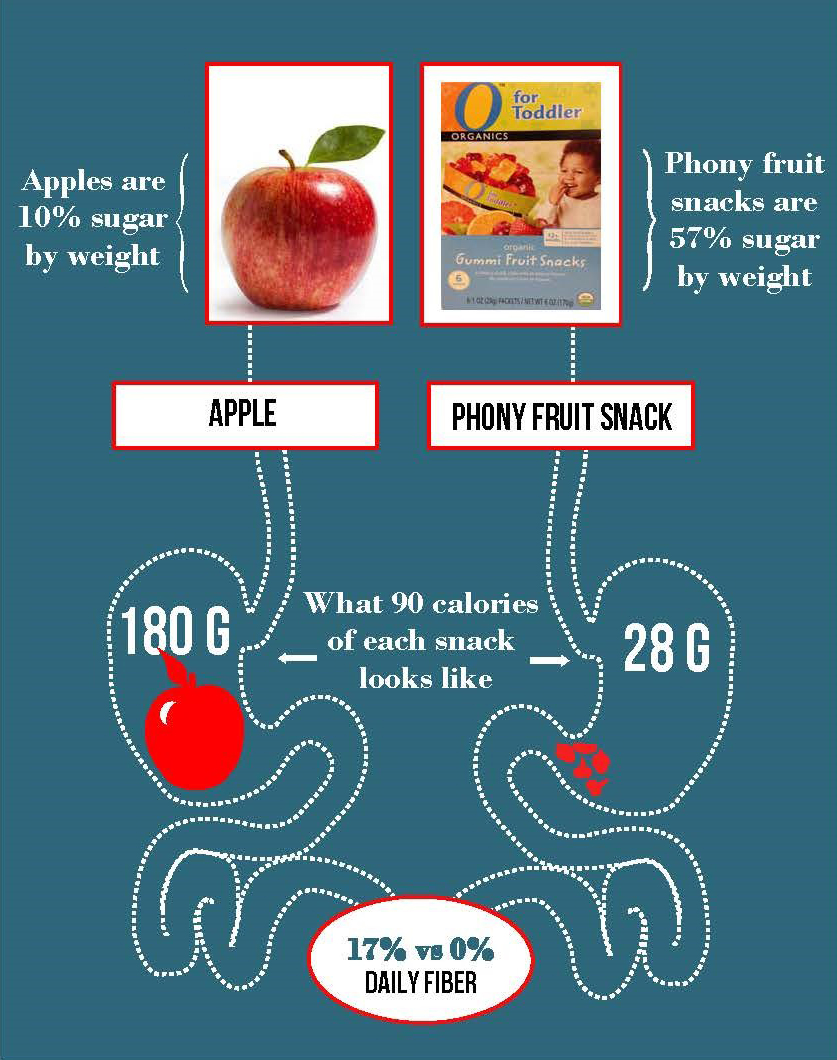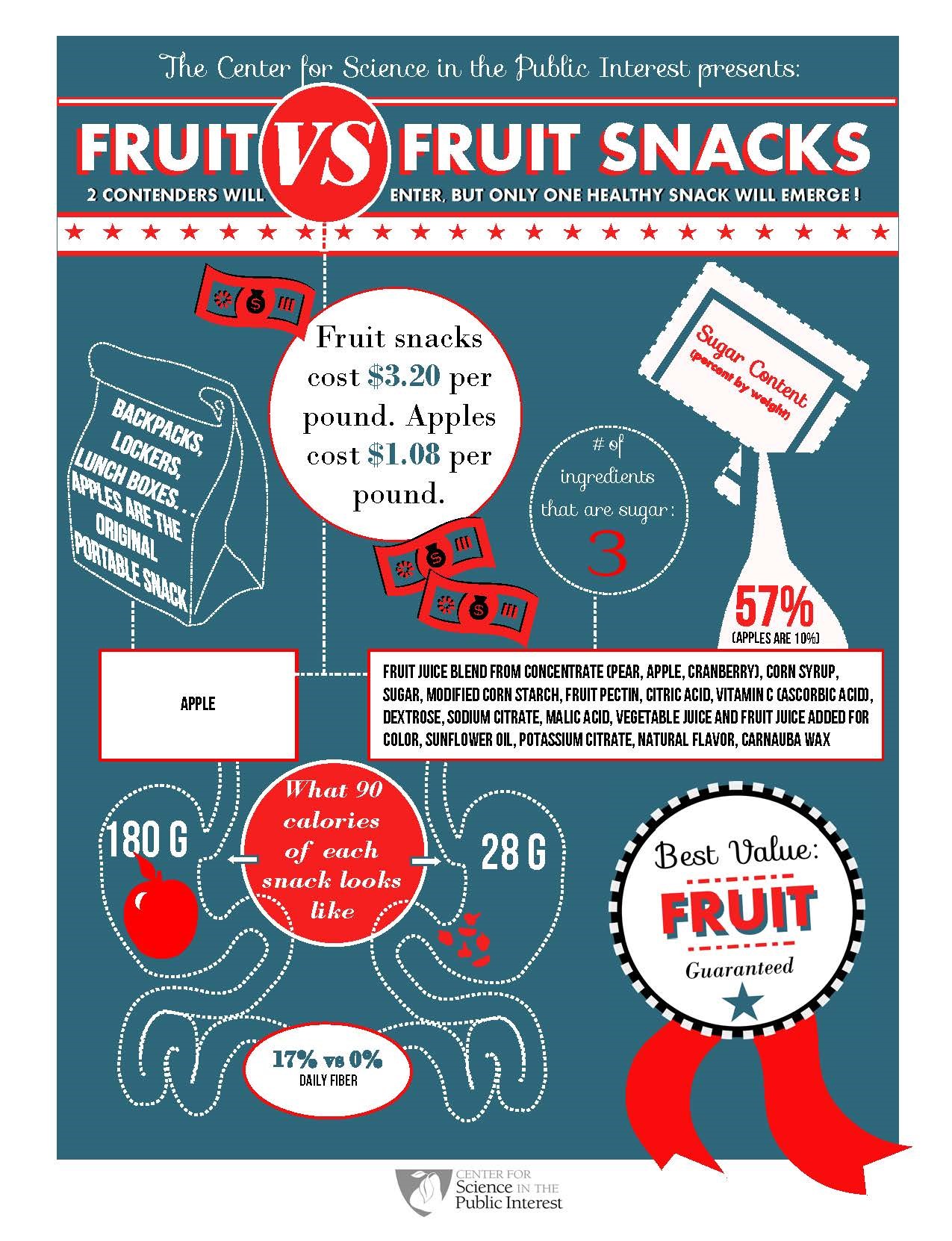
Phony Fruit Snacks
Fruit snacks are everywhere: supermarkets, convenience stores, lunch boxes, cafeterias, vending machines, afterschool snacks. But the truth is these brightly colored processed foods have a lot more “snack” than “fruit” in them.
If you are looking for healthy snacks for kids or yourself, you will want to stay away from fruit snacks like General Mill’s Fruit Roll-Ups, Fruit by the Foot, Fruit Shapes and Gushers or Kellogg’s Fruit Flavored Snacks. These and most other fruit snacks are made of mostly sugars (whether from corn syrup or concentrated fruit juice), modified cornstarch, artificial flavors, and artificial color/food dyes. In fact, if you compare ingredients lists, fruit snacks look much closer to candy—like jelly beans or gummy bears—than fruit.
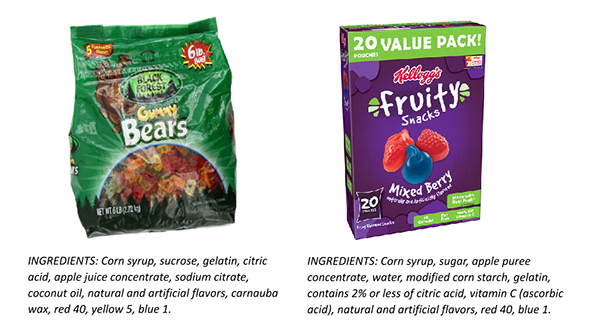
These aren’t fruit snacks... these sugar-laden treats are “Phony Fruit Snacks." Read on to learn more.
Fruit Fraud
Food companies aggressively market phony fruit snacks to toddlers, children, and their parents, pushing them as healthy options and substitutes for real fruit. Unfortunately for parents and kids, phony fruit snacks don’t always contain the fruits advertised on the front of the box and never in the quantities suggested. Instead, companies use relatively cheap, nutritionally void, and highly processed pear, apple, and white grape juices, making phony fruit snacks much closer to gummy bears than actual fruit. Still, some marketers insist these products are equal to a serving of fruit, like in the illustration below:

In reality, a package of Gerber’s “Graduates Fruit Strips” is only 1% berries, even though it’s called “Wild Berry” flavor and strawberries and raspberries are prominently displayed on the front label. The main fruit ingredient is dried apple puree, which should read “concentrated fruit sugar”.
Some phony fruit snacks don’t contain any of the fruit promised on the labels. For example, in the illustration below, Annie’s “Summer Strawberry Organic Bunny Fruit Snacks” are made only with organic white grape juice concentrate and no strawberry, despite the product’s name.
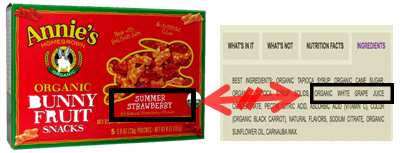
Food companies also market phony fruit snacks by making exaggerated or misleading claims on product packages, marketing them as healthier. Many phony fruit snack packages make “fat free,” “low calorie,” and “real fruit” claims, like Kellogg’s “Ultimate Spider‑Man Assorted Fruit Flavored Snacks” shown below:
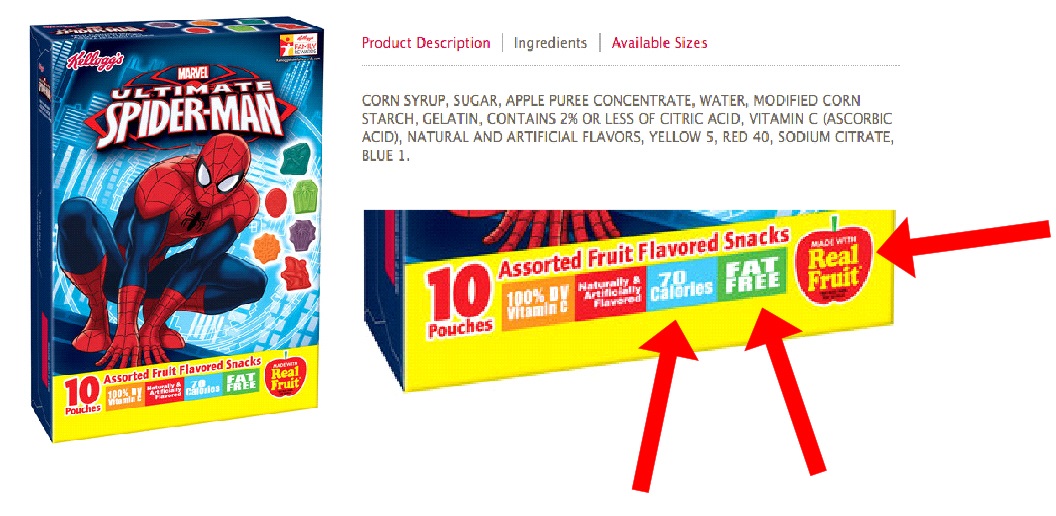
While these claims may be true, they distract from the more important point that these snacks are mostly sugar, low in nutrients, and are no substitute for real fruit.
The Dietary Guidelines Advisory Committee concluded that “nutrient intake should come primarily from foods” and that “the more scientists learn about nutrition and the human body, the more they realize the importance of eating foods in their most intact forms without added solid fats, sugars, starches, or sodium.” Another good reason to stay away from phony fruit snacks, which are mainly sugar and small amounts of fruit that has been dehydrated, pureed, concentrated, heated, and otherwise processed until it is shelf stable and largely unrecognizable, requiring colors, flavors, and vitamins to be added back in.
Phony fruit snacks are everywhere and are aggressively promoted through nutrition claims for parents and characters for children. With nine out of ten American children not eating enough vegetables and six out of ten kids not eating enough fruit, it’s time that phony fruit snacks stop masquerading as healthy options. Phony fruit snacks are usually placed in the cereal aisle in supermarkets, but given their ingredients and nutritional value, the candy aisle would be more fitting.

All Snack, No Fruit
The American Heart Association recommends no more than 3 teaspoons of added sugars a day for children ages 4 to 8. One 28 gram serving of Safeway’s O for Toddler Organic Gummi Fruit Snacks contains 16 grams of sugar, or 3.2 teaspoons—more added sugar than a young child should consume over the course of a day. The illustration below compares the nutritional content in a single pack of gummy fruit snacks to that of a medium apple (some toddlers may eat multiple packets of gummy fruit snacks, but may not need to eat an entire apple before feeling full).
Marketing to Kids
After a rigorous review of the evidence, the Institute of Medicine (IOM) concluded that “food and beverage marketing influences the diets and health prospects of children and youth” and “food and beverage marketing practices geared to children and youth are out of balance with healthful diets.” That is, by increasing children’s consumption of unhealthy foods through advertising and packaging, food marketing directly endangers children’s health.
When it comes to marketing unhealthy foods directly to children, phony fruits snack companies are some of the worst offenders. They unabashedly exploit children’s preference for their favorite characters to influence children’s diets towards unhealthy food, and make sure their brightly colored boxes are placed at children’s height in supermarkets. As the illustration below shows, seeing a shelf full of Kellogg’s Assorted Fruit Flavored Snacks in a supermarket aisle is a bit like walking by a wall of television screens.
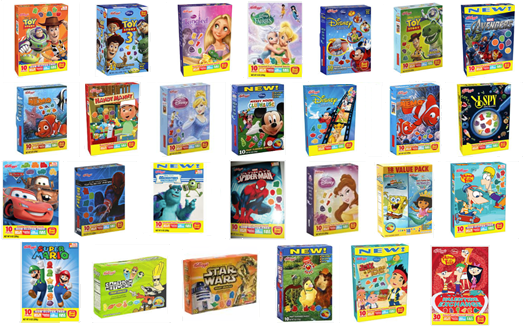
Right now, even companies that pledge not to market directly to children do not acknowledge on-package images as marketing. If you think phony fruit snack companies shouldn’t be marketing directly to children by covering their products with kid’s favorite cartoon characters and superheroes, please tweet @KelloggsUS and tell them to stop. Some example tweets are below -- simply click on the links to compose a Tweet:
- .@KelloggsUS, stop marketing directly to our kids. Take cartoon characters off of your Fruit Flavored Snacks. #phonyfruitsnacks
- .@KelloggsUS, please work with supermarkets to move your "fruit" snacks to the candy aisle. #phonyfruitsnacks
- .@KelloggsUS, why not put cartoon characters on healthy snacks, instead of on sugary, artificially-colored #phonyfruitsnacks?
Healthy Fruit Snack Alternatives
Snacks play a major role in children’s diets. Between 1977 and 2006, average snack consumption by children 2-18 years old increased by 184 calories. Snacks represent over a third of the daily energy intake of U.S. children.
Fruit and vegetables are the ultimate snack food. Serve whole, sliced, cut in half, cubed, or in wedges. Canned, frozen, and dried fruits often need little preparation. Vegetables can be served as-is, or with low-fat dip or salad dressing.
Eating fruits and vegetables lowers the risk of heart disease and high blood pressure. Fruits and vegetables also contain important nutrients like vitamins A and K, folate, magnesium, potassium, and fiber.
See more ideas here and on Pinterest.
Survey Data
Before we launched this website, we polled parents and others to find out what they thought fruit snacks should really be called. We got hundreds of great responses. Here’s a word cloud based on those suggestions:

The message is clear—people don’t think much of these so-called fruit snacks. So we combed through all the responses, to find a more accurate name for these sugar-filled, artificially colored, nutrition-poor treats. We decided on “phony fruit snacks,” but here are some of our other favorite write-ins:
- Dentist's Delight
- Sneaky Sugar Fruit Snacks
- Tooth Decay Snax
- Juiced-up Candy
- Fruit-ish Snacks
- Chewy Fruit Flavored Sugar Snacks (CFFSS)
- Fruit-Wanna-Be Snacks
- Candy with a Hint of Fruit
- Pseudo Fruit Snacks
- Fruit-Flavored Cavity Makers
- Sugar Bombs
- Fruit God Didn't Make
- Chemical Bears
- Corn Syrup Slurps
- DYE-nomites
- Call it whatever, but put it in the candy aisle.
- Fun with Fruitless Snacks
- Where's the Fruit? Snax
- Froot Snacks
- Your Dentist's Retirement Plan
- Fool-Ya Fruit Snacks
- Gummy Gunks
- Fruit Fake Out Snacks
- Bowel Blockers
- Dental Horrors
- OBCiti-snacks
- Phony Phruit Snacks
- Corn Syrup Chews
- Diabetes and Cavity Promotion Snacks
- A Food-Like Substance
- Fruity Fako's
- Crummy Candies
- Sugary Slop
- Fruit-Free Snack Packs
- Sugar Roll-Ups
- Quasi-Fruit Candies
- Energy Crushers
- Should Have Had the Real Thing
- Fool Me Fruitless Snacks
- "Fruit" Snacks
- Faux Fruit Snax
- Fruit Imposters
- What Is This Junk Snack
- Fruity McFakersnacks
- Candy Chemistry
- Fruit Frauds
- A Waste of Money
- Unfruit Candies
- Turn around! Apples are at the entrance of the store!
- HPFP-"Highly Processed Fruity Product"
- Nothing with the word fruit. Candy is candy.
Fruit vs. Fruit Snacks Infographic
Click image to view a larger version.
Blog Posts
For more on phony fruit snacks, check out the following blog posts from some of our partners:


